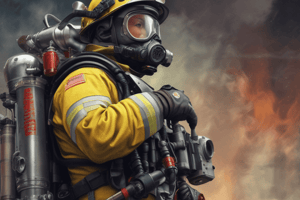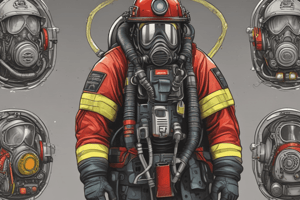Podcast
Questions and Answers
What is the primary difference between Level I and Level II Rehabilitation?
What is the primary difference between Level I and Level II Rehabilitation?
- Level I is for prolonged situations, Level II is for emergencies.
- Level I requires hydration only, while Level II includes medical evaluation.
- Level I can be managed by the Incident Commander, while Level II requires EMS involvement. (correct)
- Level I involves outdoor activities, whereas Level II is indoors.
Which of the following is NOT a goal of the personnel rehabilitation process?
Which of the following is NOT a goal of the personnel rehabilitation process?
- Provide hydration and nutritional replenishment.
- Medical evaluation and treatment if necessary.
- Relief from extreme climatic conditions.
- To improve firefighters' performance during training. (correct)
What resources are essential for Level II Rehabilitation?
What resources are essential for Level II Rehabilitation?
- Only water and chairs.
- Personal equipment of the firefighters.
- One EMS unit and a designated Supervisor. (correct)
- Personnel from the same crew only.
What is the main purpose of medical evaluations during the rehabilitation process?
What is the main purpose of medical evaluations during the rehabilitation process?
Which statement accurately differentiates between informal and formal rehabilitation?
Which statement accurately differentiates between informal and formal rehabilitation?
What is a critical factor to consider when establishing a Rehab Operation during an incident?
What is a critical factor to consider when establishing a Rehab Operation during an incident?
Which of the following is NOT an objective of a Level I Rehab Operation?
Which of the following is NOT an objective of a Level I Rehab Operation?
When is self rehabilitation appropriate during routine incidents?
When is self rehabilitation appropriate during routine incidents?
What additional responsibilities are included in a Level II Rehab Operation compared to Level I?
What additional responsibilities are included in a Level II Rehab Operation compared to Level I?
Why is crew integrity essential during rehab operations?
Why is crew integrity essential during rehab operations?
What is a common misconception about hydration during rehab operations?
What is a common misconception about hydration during rehab operations?
What process should the Company Officer follow when entering a Level II Rehab Operation?
What process should the Company Officer follow when entering a Level II Rehab Operation?
What does effective restoration of personnel during rehab NOT include?
What does effective restoration of personnel during rehab NOT include?
What should be regularly monitored during rehab to ensure personnel well-being?
What should be regularly monitored during rehab to ensure personnel well-being?
How does self-rehabilitation differ from formal rehab operations?
How does self-rehabilitation differ from formal rehab operations?
What is the main purpose of recycling for crews during operations?
What is the main purpose of recycling for crews during operations?
What is critical for crews to communicate during the recycling process?
What is critical for crews to communicate during the recycling process?
What should personnel be cautious of regarding their physical condition?
What should personnel be cautious of regarding their physical condition?
Once crews have recycled, how many times can they do so consecutively before being sent to rehab?
Once crews have recycled, how many times can they do so consecutively before being sent to rehab?
Which responsibility is explicitly outlined for Company Officers during the rehab process?
Which responsibility is explicitly outlined for Company Officers during the rehab process?
What is a recommended practice for personnel before, during, and after an incident?
What is a recommended practice for personnel before, during, and after an incident?
During which stage should crew integrity be maintained?
During which stage should crew integrity be maintained?
Why is recycling preferred over formal rehab in certain situations?
Why is recycling preferred over formal rehab in certain situations?
What is the minimum personnel requirement at Level II Rehab?
What is the minimum personnel requirement at Level II Rehab?
What should be done if a person's heart rate remains above 110 bpm?
What should be done if a person's heart rate remains above 110 bpm?
Which of the following criteria must be met for personnel to be released from rehab?
Which of the following criteria must be met for personnel to be released from rehab?
What is the purpose of taking vitals during each rehab rotation?
What is the purpose of taking vitals during each rehab rotation?
What should EMS personnel assess upon arrival of members in rehab?
What should EMS personnel assess upon arrival of members in rehab?
What action should be taken if personnel are outside normal parameters during rehab?
What action should be taken if personnel are outside normal parameters during rehab?
How should skin color and condition be assessed during rehab evaluations?
How should skin color and condition be assessed during rehab evaluations?
What is considered an 'assignment' in the context of Rehab?
What is considered an 'assignment' in the context of Rehab?
What happens once a personnel member is directed to medical treatment?
What happens once a personnel member is directed to medical treatment?
What is the primary responsibility of the Rehab Group Supervisor during Level II Rehab operations?
What is the primary responsibility of the Rehab Group Supervisor during Level II Rehab operations?
Which factor is NOT considered by the Rehab Supervisor in regards to personnel rehabilitation?
Which factor is NOT considered by the Rehab Supervisor in regards to personnel rehabilitation?
In what scenario does the Instructor In Charge (IIC) assume responsibility for rehab?
In what scenario does the Instructor In Charge (IIC) assume responsibility for rehab?
What is the appropriate action regarding the location of the rehab area?
What is the appropriate action regarding the location of the rehab area?
Who does the Rehab Supervisor report to during incident operations?
Who does the Rehab Supervisor report to during incident operations?
What should NOT be included in the rehabilitation provisions?
What should NOT be included in the rehabilitation provisions?
During which type of event is the fire department officer responsible for rehab?
During which type of event is the fire department officer responsible for rehab?
Which condition should NOT be a consideration for rehabilitation?
Which condition should NOT be a consideration for rehabilitation?
Which of the following is an essential element of the rehab process?
Which of the following is an essential element of the rehab process?
What is the function of the radio designator 'Rehab'?
What is the function of the radio designator 'Rehab'?
Flashcards are hidden until you start studying
Study Notes
Recycling vs. Rehabilitation
- Recycling allows crews to continue working without undergoing formal rehab, necessary when SCBAs alarm at 1/3 of a cylinder.
- Crew officers decide when to recycle or go to formal rehab, coordinating with the Incident Commander (IC).
- Crews can recycle one or two times before mandatory formal rehab; communication with the IC is essential throughout.
Responsibilities of Personnel
- Personnel must maintain physical conditioning to combat negative effects of strenuous activities.
- Employees should disclose physical or mental conditions and medications that impair performance.
- Hydration and nutrition should be prioritized before, during, and after incidents or training.
- Crew integrity and accountability are crucial during rehab processes.
Establishment of Rehab Operations
- A Rehab Operation should be considered early in an incident and re-evaluated based on the incident's needs.
- Factors influencing rehab include incident size, duration, environmental conditions, and physical intensity.
- Self-rehabilitation can occur during breaks in routine incidents, ensuring accountability procedures are followed.
Level I Rehab Operation
- Objectives include adjusting clothing/PPE, at least 10 minutes rest, hydration, and self-monitoring for medical needs.
Level II Rehab Operation
- Includes all Level I objectives plus documented check-in/out processes managed by a Rehab Group Supervisor.
- The Company Officer checks in with a PAR report and ensures proper hydration/nutrition for crew members.
Location of Rehab
- Rehab sites should be distanced from operational effects and provide mental rest from stress.
- Should be positioned away from hazards such as combustion products and environmental stressors, ensuring appropriate shelter from weather.
Medical Evaluations
- At least two EMS personnel, including one paramedic, must be present during Level II Rehab.
- Vitals are recorded both upon entry and exit, assessing heart rate, blood pressure, and symptoms of dehydration or stress.
- Personnel can only leave rehab if specific criteria are met, such as a heart rate below 100 bpm and controlled blood pressure.
Procedures for Personnel Outside of Norms
- If maintaining elevated heart rates, additional monitoring and potential reevaluation through another rehab period are necessary.
- Personnel consistently outside set medical thresholds are treated as patients within rehab protocols.
Purpose and Scope of SOP 622
- Aims to maintain the physical and mental condition of personnel during emergency responses, training, or special events to ensure safety.
- Applies to all strenuous activities that necessitate rehabilitation processes for crews to withstand extreme conditions.
Definitions of Rehab Levels
- Level I Rehab: Informal, for brief situations, providing basic hydration and rest.
- Level II Rehab: Formal, requiring significant resources, including EMS, and enhanced supervision by a designated Rehab Supervisor.
Studying That Suits You
Use AI to generate personalized quizzes and flashcards to suit your learning preferences.



